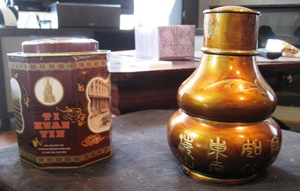At last, it’s been found for me, my first tea love!
Actually, it’s more like her younger and more ferocious cousin. Loud bark, but very gentle once you take the time to understand her.
First, some background. By way of circumstance and opportunity, the bulk of my tea learning has taken place in Taiwan. It’s there that I was able to learn more about Dong Ding Oolong (my other favorite) and Muzha Tieguanyin. Tieguanyin originally comes from Fujian and the best-known production area for it is Anxi. The skills to make a traditional charcoal roasted oolong with moderate oxidation levels have deteriorated rapidly as preferences have changed to favor fresher, lighter tastes. For years, I have searched for a round, complex and strong Anxi Tieguanyin with the beautiful mouth-feel and lingering, sweet finish (called guanyin yun), but have failed to find both the right product and the right teacher. So it was in Taiwan that I was able to study the Muzha variant, itself as worthy as its Anxi counterpart; but they’re not the same. Like two buckets of Haagen-Dazs ice cream, I will surely love both, but one will be particularly special (and that would be caramel cone – fantastic!).
What are the differences between the two variants of Tieguanyin? Actually, there are multitudes of variants and other lesser-known production areas. The tea now comes in a vast range from super green (one would think it a green tea) to a deep amber, bitter, espresso-roast (I call that “oopsie” tea – too much fire). I find that both types of tea with similar levels of oxidation and roasting will exhibit a clear fruit bouquet that is oftentimes accompanied (in the finish) by a subtle floral note. What type of fruit? When I think of a good Anxi Tieguanyin, I am reminded of ripe fruit, like a mushy apricot. For Muzha, I cannot quite pinpoint what fruit the taste reminds me of, for the smell and the taste are not quite as in sync as for Anxi. The floral aspect has hints of osmanthus, and if pushed to pick one fruit, I would say the taste (taste only, not smell) makes me think of an unsweetened jackfruit.
After two years of listening to me go off about how much I love Anxi tea, my friend – a tea retailer and lover of Fujian oolongs also – was able to source a limited quantity of the tea I’ve been looking for. It is the best he could find after several seasons of searching, and unfortunately, by the time you read this post, it will probably have sold out.
I know, the chintzy looking can on the left looks like it could have been found in a Chinatown grocery store. It is, however, 1/2 the size and double the cost of it’s older pal to the right.
Both of these teas are charcoal-fired Anxi Tieguanyin, aged 12 years (left) and 15-20 years (right). The older of the teas has been periodically re-fired, so it doesn’t have the tartness or mustiness of a tea of its age. There is some serious firepower in this tea though and the roast is alive and strong. It is robust and delicious, but will be better to drink after a few months in that pewter jar.
The tea on the left is younger and the base isn’t as robust, but it is also an exceptional tea. It has never been fired again, so it’s got a mustiness to it. However, the brew is soft and the mouth-feel is delicate. It exhibits light fruit notes in the scent, and assertive fruit flavors in the finish. Another 10 years or so and this tea will be quite a winner.
These teas represent a part of the history of tea, a time when producers roasted small batches of tea for days on end without the aid of machinery. The charcoal flame’s temperature was calibrated by hand, and one roast – out of a total of 3 or 4 – could take a day or two to complete in a small and hot room. I’m not merely romanticizing this tea when I say that there is more passion and skill in it; this is the type of stuff that old tea makers horde for themselves in the nooks and crannies of their stores. Nowadays, it takes too much work to make this type of tea and there is not enough demand, either. Drinking a good, roasted Anxi Tieguanyin is a completely satisfying experience. It layers the beauty of its organic notes behind its fiery roast and gives you the pleasure of a substantive, round and satisfying mouth-feel. The finish is dually flavored and dry, leaving you wanting to quench your thirst with another unending cup. This tea is not shy when brewed in a pot, but it will imprint upon an understanding tea drinker quite a memorable experience.
Not all teas are created equal; this one harkens back to my earliest tea experiences. It just feels like one of those days to kick back and have another cup. Drink good tea and enrich your life.








